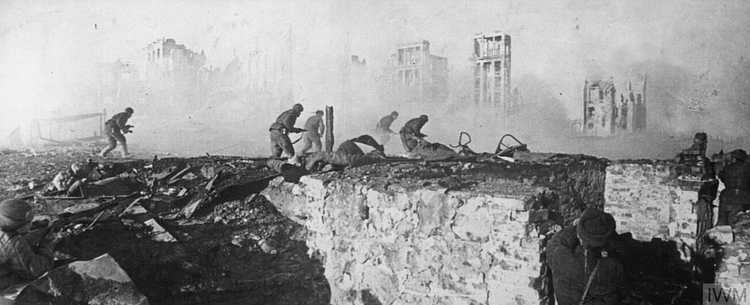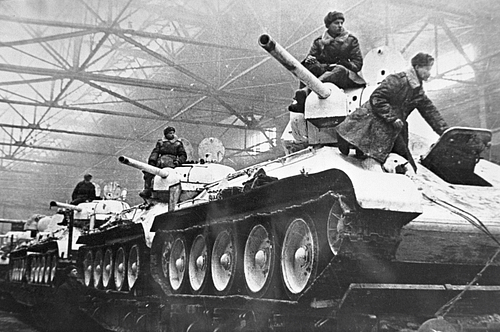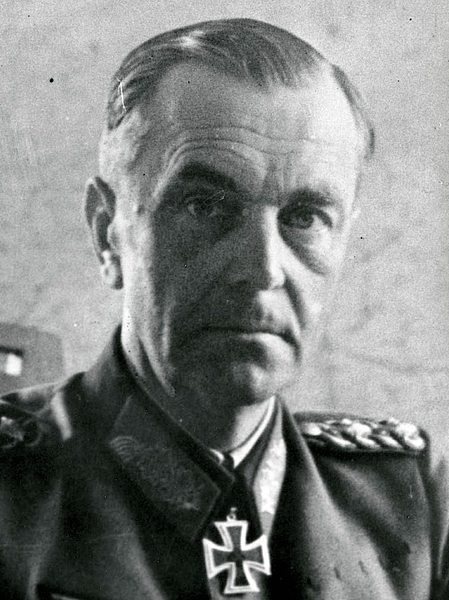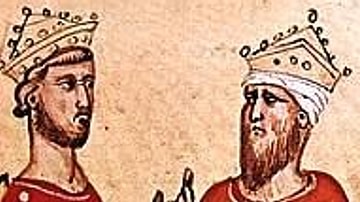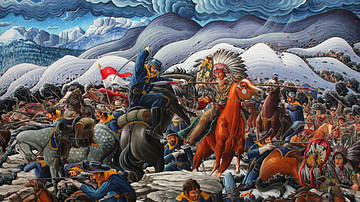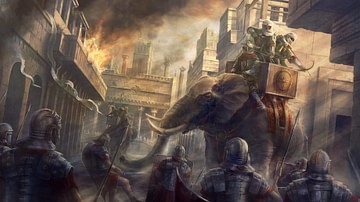The Battle of Stalingrad (now Volgograd, July 1942 to February 1943) was an attempt by Adolf Hitler (1889-1945) to control the USSR's access to the Caucasus oil fields. Fierce street-fighting by the Soviet Red Army saw the city withstand the attack until a massive counteroffensive was launched, which encircled Hitler's Sixth Army.
Considered a turning point of the German-Soviet War, Stalingrad resulted in the destruction of an entire army and the surrender of 91,000 troops, including field marshal Friedrich Paulus (1890-1957). One of the greatest victories of the USSR in the Second World War (1939-45), Hitler's armies never recovered and thereafter fought a defensive war of retreat.

The Campaign So Far
Adolf Hitler, the leader of Nazi Germany, had launched his attack on the USSR, Operation Barbarossa, in June 1941. Sweeping victories soon followed thanks to Blitzkrieg ('Lightning war') tactics, which combined air support with fast-moving armoured and infantry divisions advancing on narrow fronts. When it came to taking large cities, though, the invaders were less successful. The Battle of Moscow (October 1941 to January 1942) was won by the Soviet Red Army. The siege of Leningrad dragged on for years as that city held out, too. Stalingrad, in the south of the USSR, would prove an equally tough objective for the Axis armies to take.
Stalin's City
Stalingrad ('Stalin's city') was formerly known as Tsaritsyn, but it was renamed in 1925 after the leader of the USSR, Joseph Stalin (in 1967, it changed its name to Volgograd). The city had long possessed a fortress, indeed, that was the reason for its very existence, protecting the joining of the Volga and Tsaritsa rivers and access to the southern borderlands of Russia. Vital supplies for the Soviet war effort, including oil from the Caucasus, came through Stalingrad, itself a valuable industrial centre. If Hitler could capture this city, "the Soviets would be struck a devastating economic blow" (Rees, 142).
Opposing Armies
The task of taking Stalingrad, Operation Heron, was given to General Paulus, commander of the Sixth Army, Hitler's largest. Paulus had little battlefield experience since he had been serving as a staff officer so far in the war. Paulus had assisted in the planning of Operation Barbarossa, and, in May 1942, he had contributed to the victory at the Second Battle of Kharkov (Kharkiv). In all, the Axis forces ranged against the city of Stalingrad itself numbered just short of 300,000 men (Antill, 54).
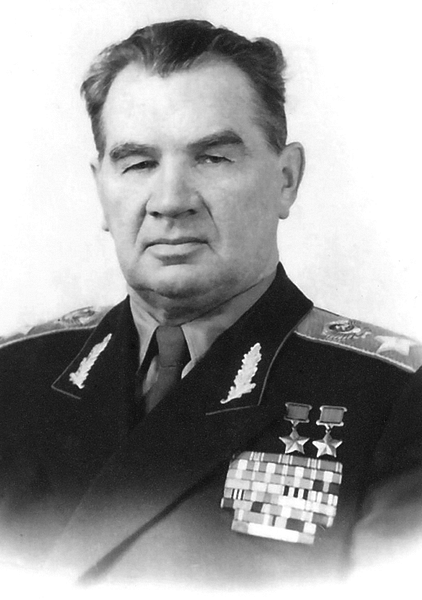
A second army at Stalingrad was the Fourth Panzer Army, led by General Hermann Hoth (1885-1971). A third army involved was Army Group B under General Maximilian von Weichs (1881-1954). There were, too, several other Axis allied armies positioned at the flanks of the Stalingrad front. These Romanian, Hungarian, and Italian armies were not as well-trained, well-equipped or experienced as their German counterparts.
The difficult problem of the defence of Stalingrad, a city which was strung out for around 25 miles (40 km) along the western bank of the Volga, was in the hands of the 62nd Army led by Major-General Vasily Chuikov (1900-1982). Known to his men as 'General Stubbornness' and famous for his glittering smile of gold crowns, Chuikov promised Stalin: "We shall either hold the city or die there" (Dear, 183). The Red Army in Stalingrad numbered around 54,000 men (Antill, 54), but crucially, Chuikov received continuous reinforcements and material from the eastern side of the Volga.
After winning a battle east of Kalach and capturing 50,000 Soviet prisoners on 7 August, Paulus pushed on to Stalingrad. Given the ease of the advance, Hitler denuded the Sixth Army of some of its armoured divisions and redirected them to the ongoing campaign in the Caucasus. Towards the end of August, Paulus began to assemble his armies for a wide-front attack on Stalingrad, now just 9 miles (15 km) away. On 29 August, General Georgi Zhukov (1896-1974) took overall command of the wider Stalingrad front and made plans for a counteroffensive code-named Operation Uranus, scheduled to begin in November. Zhukov was then moved elsewhere, and the actual execution of Uranus was left in the hands of General Aleksandr Vasilevsky (1895-1977).
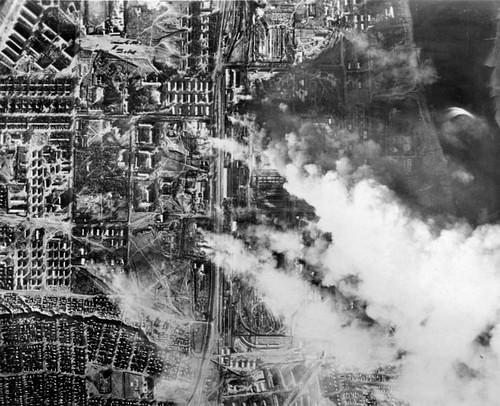
The Street-Fighting in Stalingrad
Stalingrad had been put on a war footing on 19 July. Stalin decided that, for the morale of the entire country, the city that bore his name had to be held, whatever the cost. Local militias were formed, and these units included women, as did many of the city's anti-aircraft units. Each block, each street, and each building was to be held for as long as possible.
On 4 August, the Axis army crossed the Aksay River and headed toward the city. On 19 August, Paulus ordered the Sixth Army's attack on Stalingrad. The outer limits of the city were reached on 3 September. 600 Axis aircraft had repeatedly and indiscriminately bombed Stalingrad from 23 to 26 August in preparation for this first ground assault. The Axis troops entered the city proper on 12 September 1942. Paulus would launch another two assault waves, one on 27 September and another on 14 October. In order to minimise casualties from bombing and artillery fire, Soviet soldiers were told to stay as close as possible to Axis positions.
The fighting was often brutal as every metre of rubble, trenches, sewers, and underground bolt holes had to be cleared. Snipers from both sides made any rash movements fatal. Soviet tanks were deliberately hidden in rubble and fired on the enemy with total surprise. The German soldiers described this unfamiliar style of fighting as Rattenkrieg or 'war of the rats'. While Axis commanders struggled to figure out how exactly to command their men in such conditions, Chuikov innovated the use of shock groups of 50-100 men who had absolute autonomy on how best to fight the enemy they came across.
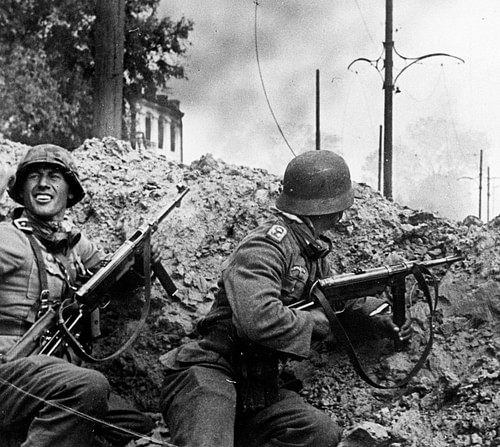
Private Wilhelm Hoffman of the Sixth Army recorded in his diary the ferocity of the fighting:
11 September: Our battalion is fighting in the suburbs of Stalingrad. Firing is going on all the time. Wherever you look is fire and flames. Russian cannon and machine guns are firing out of the burning city – fanatics!
16 September: Our battalion plus tanks is attacking the grain elevator. The battalion is suffering heavy losses. The elevator is occupied not by men but by devils no bullets or flames can destroy.
18 September: Fighting is going on inside the elevator. If all the buildings of Stalingrad are defended like this none of our soldiers will get back to Germany.
(Holmes, 285).
A Soviet soldier, Private Anton Bosnik, explains why it was so tough to free buildings of their defenders:
We moved back occupying one building after another, turning them to strongholds. A soldier would crawl out of an occupied position only when the ground was on fire beneath him and his clothes were smouldering.
(ibid)
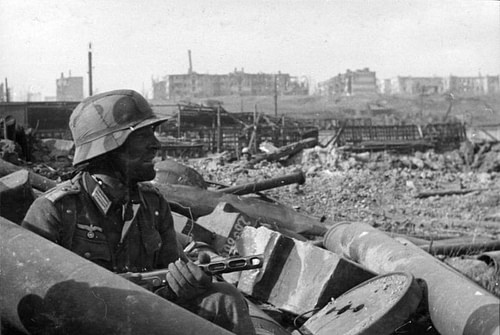
By 26 October, Hoffman was still fighting, but his diary notes: "The soldiers are calling Stalingrad the mass grave of the Wehrmacht" (ibid). Another soldier, Lieutenant Reiner of the Fourth Panzer Army, noted in a letter home:
Stalingrad is no longer a town. By day it is an enormous cloud of burning, blinding smoke, a vast furnace lit by the reflection of the flames. And when night arrives, one of those very hot, noisy, bloody nights, the dogs plunge into the Volga and swim desperately to gain the other bank. The nights of Stalingrad are a terror for them. Animals flee from this hell. The hardest stone cannot bear it for long. Only men endure.
(Holmes, 286)
When the Axis forces finally controlled nine-tenths of the city, Hitler made a rash speech on 8 November, which declared that Stalingrad had practically fallen. The Red Army, though, had other ideas as it now launched a massive counteroffensive. The army groups to the north and the south of the city were ordered to attack the wider Stalingrad front, punch through in two pincer movements, and then audaciously encircle the Sixth Army. For weeks, the Red Army had been building up its forces, moving only at night, maintaining radio silence, and then camouflaging the masses of tanks and infantry to achieve not perhaps total surprise but certainly a shock to the enemy regarding the scale of the operation.
The Sixth Army Pocket
The weak points of the Axis lines on the Stalingrad front were the Romanian Third and Fourth Armies, the Italian Eighth Army, and the Hungarian Second Army. Lieutenant-General Nikolai Fedorovich Vatutin (1901-1944) directed two field armies and one tank army to hit the Third Romanian Army on 19 November, the beginning of Operation Uranus. Before the Red Army moved through the falling snow, a massive artillery barrage had hit the enemy lines. On 20 November, the Fourth Romanian Army was attacked by the 51st Army led by Lieutenant-General Andrey Eremenko (also spelt as Yeryomenko, 1892-1970). The Axis armies on the wings of the front completely buckled, and, on 23 November, as the pincers closed near Kalach, the Sixth Army was encircled.
Paulus now requested from Hitler permission to withdraw his 250,000 troops from the Stalingrad pocket. This area measured around 37 miles (60 km) from east to west and 28 miles (45 km) from north to south. Hitler refused to allow a retreat, as he did so many times during the campaign, but he did promise that supplies would be flown in by air. Hermann Göring (1893-1946), head of the Luftwaffe (German air force), had promised Hitler he could deliver 300 tons of vital supplies every 24 hours. Studies had already revealed that supplying the Sixth Army with what it required by air was impossible for lack of suitable transport aircraft, fighter cover, and the poor weather. Hitler, nevertheless, grasped Göring's promise as a desperate lifeline and, in sympathy with the privations of the soldiers at Stalingrad, forbade the drinking of champagne and cognac at his headquarters, at least for a few weeks.
A large relief force was organised by Field Marshal Erich von Manstein (1887-1973), Hitler's greatest troubleshooter. This force, commanded by General Hermann Hoth (1885-1971) in the field, consisted of three panzer divisions and two infantry divisions. The plan, Operation Winter Tempest, was to cut a corridor through the enemy's ring around the Sixth Army, which would allow Paulus to withdraw. Manstein insisted that for the relief to be effective, Paulus had to retreat to meet Hoth's advance, but Hitler would have none of it and insisted the Sixth Army not withdraw one step from Stalingrad. Hoth's relief force began its attack on 12 December.
The Soviets responded to the Axis relief force approaching from the south by attacking the Italian Eighth Army on 16 December. The Soviet front was now pushing both west and south of Stalingrad. Hoth's relief force did manage to get to within 30 miles (km) of the pocket on 19 December, but no closer. If the Sixth Army had now broken out of the pocket, it would very likely have successfully joined Hoth's army, but still Hitler rejected the idea.
Meanwhile, Paulus' Sixth Army was only receiving 90 tons of supplies per day in the airlift – totally inadequate for the army's needs, estimated by Paulus as a minimum of 750-800 tons per day. Even worse, by 28 December, Manstein was obliged to withdraw Hoth's relief force from the battle as it was itself in serious danger of being encircled. The Sixth Army was on its own.
By January 1943, the Stalingrad pocket was receiving slightly more supplies by air, on average 120 tons per day, but it was still not enough, and troops had to endure meagre food rations. The conditions in the heavy snow are here described by Bernhard Bechler:
When I lay down and stuck my hand under the collar, my hand would be full of lice. And the lice carried typhus…We had nothing to eat. There were some frozen horses and we took an axe and chopped some meat and heated it up in a pot just to have something to eat. We were just lying there, without any food, almost frozen to death, it was dreadful.
(Rees, 182)
On 8 January, Paulus was invited to surrender by a delegation of three Red Army officers. Paulus requested from Hitler freedom of action to respond, but a surrender was again forbidden. Hitler believed that every day the Sixth Army held out would help the Axis forces in the south avoid being cut off by the Soviet advance.
Just under 30,000 wounded were evacuated from the pocket in the empty transport planes. For those who remained, fighting on had already become impossible, as here described by Bechler:
One day three Red Army soldiers approached our little foxhole. We were living in there, my adjutant – a young lieutenant – and me…Suddenly these Red Army soldiers were coming towards us. And we both thought in a flash, we don't have any ammunition, this is the end. They're either going to shoot us or they'll take us prisoner. What shall we do? At that point I saw my adjutant pull a photo from the pocket of his uniform jacket. I looked at it, and it was a photo of his young wife with two very young children. He glanced at the photo, tore it to pieces, pulled his handgun, shot himself in the head and was dead…The following moment the Red Army soldier was upon me. He held his pistol to my chest, but he didn't pull the trigger, and at that point, when I realized he wasn't going to shoot me, my second life began.
(Rees, 184)
On 10 January, after a huge artillery bombardment, a Soviet army commanded by Lieutenant-General Konstantin Rokossovsky (1896-1968) punctured the pocket and drove about halfway through it over the next week. Paulus now had only one airfield operational and was himself sheltering in the basement of a bombed-out department store. On 24 January, another Soviet delegation offered Paulus the opportunity to surrender. Again, the besieged general requested permission from Hitler. The Führer responded with the following message:
Surrender is forbidden. Sixth Army will hold their positions to the last man and the last round and by their heroic endurance will make an unforgettable contribution toward the establishment of a defensive front and the salvation of the Western world.
(Shirer, 930)
There were now only two much-reduced pockets offering effective resistance. On 30 January, Hitler chose this moment to promote Paulus to field marshal, a move regarded by many historians as a strong hint for Paulus to commit suicide. The commander's beliefs forbade suicide, as he told a battalion commander Gerhard Hindenlang on 30 January: "Hindenlang, I'm a Christian. I refuse to commit suicide" (Rees, 185). On 31 January, Paulus surrendered the pocket he was himself in but did not order the second pocket to do likewise. Hitler sent orders to this pocket that each man should fight to the death. On 2 February, this final pocket was overrun by the Red Army.
A field marshal had surrendered for the first time in the history of the German Army. The Sixth Army had lost around 275,000 men at Stalingrad. 150,000 men had been killed, and 91,000 troops were taken as prisoners of war (20,000 of whom were wounded men). Amongst the prisoners were 24 generals. Paulus has been criticised for not disobeying Hitler's orders, as several other army commanders did in similar situations. This point is noted by the historian M. M. Boatner: "A tougher, more decisive, and more experienced general might have salvaged something from the campaign" (417). The non-German Axis armies also suffered heavy losses. Italy lost 110,000 men (killed or wounded), Hungary 143,000, and Romania 160,000. These countries could not replace such losses. On the other side, victory came at a high price. Two million civilians died at Stalingrad from starvation or enemy fire (Rees, 177).
Aftermath
Hitler announced the defeat to the German people via radio on 3 February, a communication which ended with the playing of the second movement of the Fifth Symphony by Ludwig van Beethoven (1770-1827). As a mark of respect for the fallen, Hitler declared four days of national mourning, during which all theatres and cinemas were closed.
The long defeat at Stalingrad did allow the Axis Army Group A to withdraw from the south and avoid a similar fate to the Sixth Army. Hitler was certainly able to fight on, but the defeat at Stalingrad also showed that he could never win a war of attrition against the USSR with its much greater capacity for industrial production and to replace combatant losses in the field. The defeat had a strong psychological effect, as the historian J. Dimbleby notes: "It was a catastrophe for the Third Reich, a shattering blow to its already shaken morale" (498). For the USSR, the successful defence of Stalingrad was a highlight of the war. The city had been destroyed in the battle, but it was rebuilt and officially awarded 'Hero' status.
WWII in Europe ended with the fall of Berlin in May 1945. Field Marshal Paulus gave testimony at the post-war Nuremberg trials and was released from Soviet captivity in 1953. Paulus had fared better than most of his compatriots. Of the 91,000 men sent to Soviet prison camps after their surrender at Stalingrad, only around 5,000 ever returned home.
